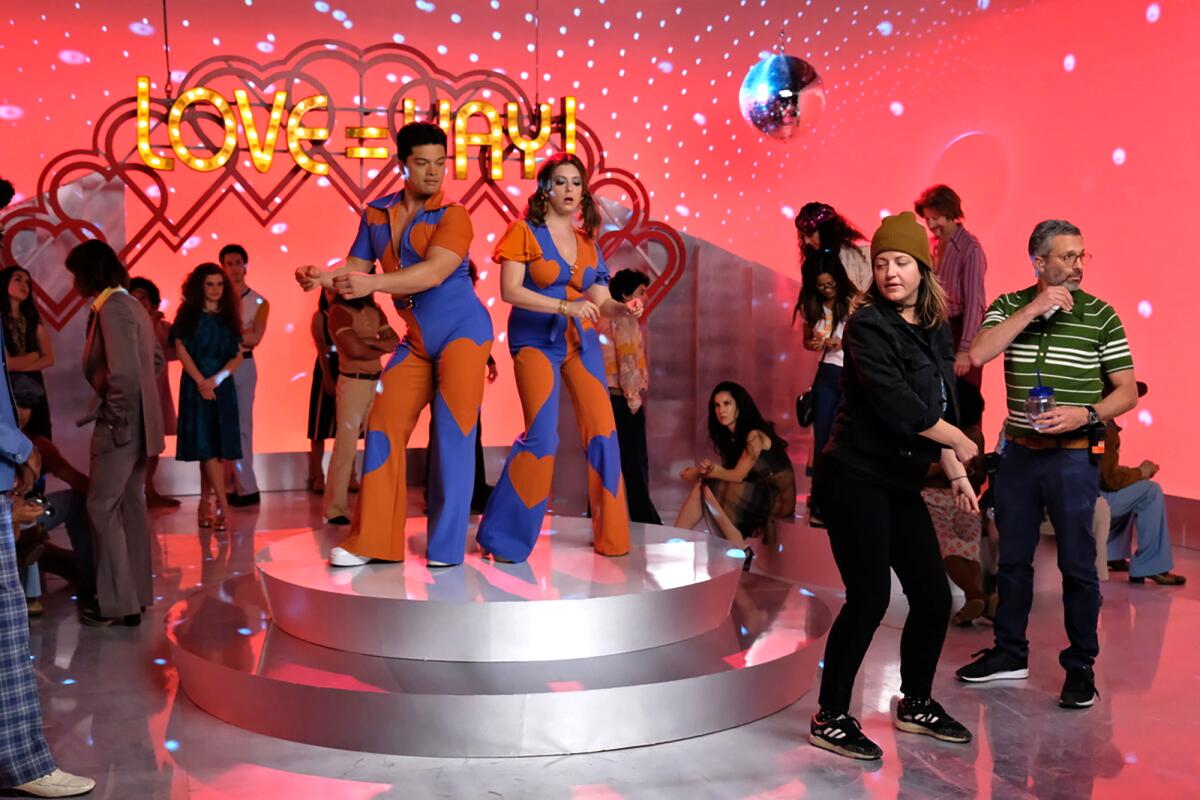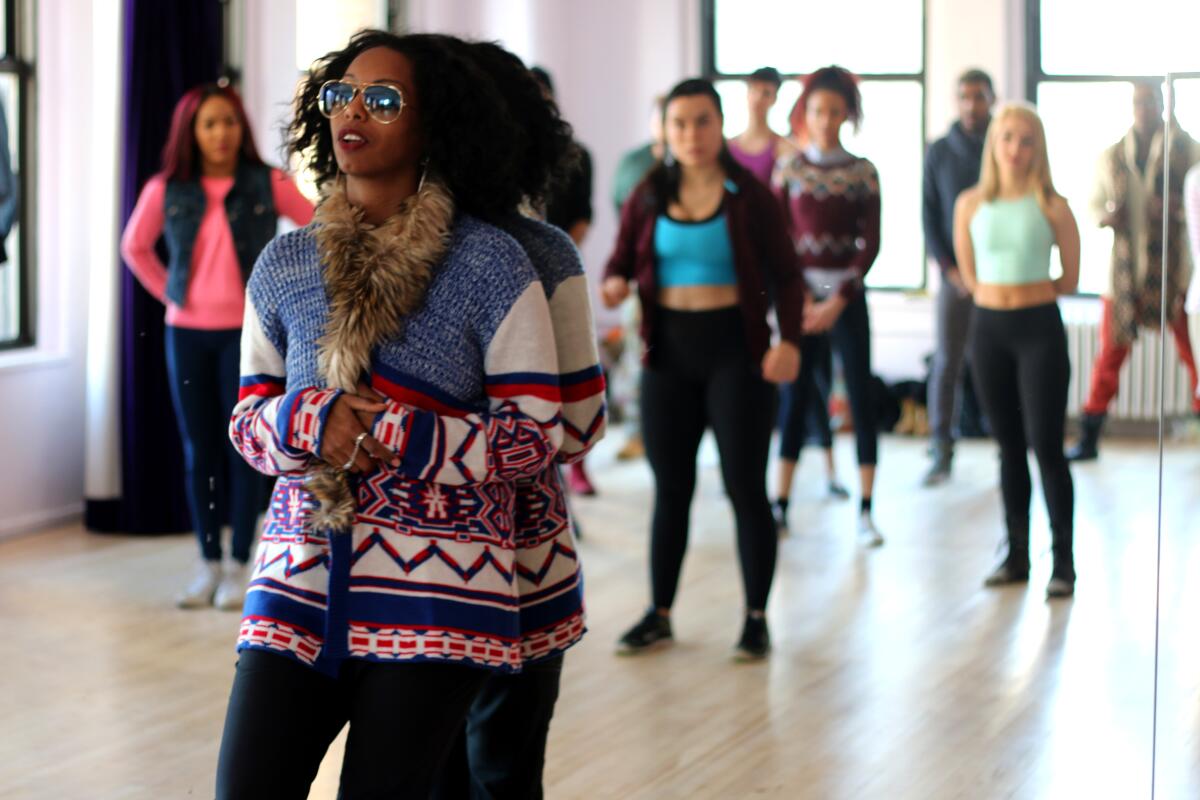Choreographers’ work in film and TV often goes uncredited. A new guild aims to change that

- Share via
Some of our favorite film and TV moments involve a dance sequence. “La La Land” opens with dancers hopping on top of cars, jumping in unison and weaving through the lanes of the 110. Season one of “Euphoria” closes with a large ensemble of people throwing their hands up before lifting Zendaya atop a hill of bodies. And between scenes in “Don’t Worry Darling,” dancers lie on their backs, swinging their legs back and forth at the camera in a Busby Berkeley-style formation.
While these moments are memorable and often pivotal to storytelling, the names of choreographers and movement directors behind them are seldom mentioned. Those working in the field aren’t often given their due for their contributions to film, television, music and live performances: Consider how, if you try to search for choreographers’ names on IMDb who worked on “La La Land,” “Euphoria” and “Don’t Worry Darling,” their names are located at the very bottom of the credits under “Additional Crew.”
“You’ll barely find us as recognized,” Choreographers Guild vice president Luam Keflezgy says.
At a time when choreography has become more visible than ever, with the likes of JaQuel Knight and Parris Goebel making headlines, choreographers who bring these pieces of media to life often have little guidance and support. Keflezgy says that this happens because there is no system in place supporting their contributions.
If you were one of more than 500 million recent YouTube views for Justin Bieber’s song “Sorry” and were dazzled by the dancing, know that the moves originated from the mind of choreographer Parris Goebel.
The recently formed Choreographers Guild hopes to address the lack of transparency and collectively — with input from members — outline standards for their work in entertainment. The guild operates under four tenets: economic security, credit, strengthening copyright and education. Their next step to achieving those goals started last week, as they have now opened membership to those wishing to join. The goal of the guild is to represent choreographers, assistant choreographers, associate choreographers and movement coaches working in music videos, film, television, tours, commercials and social media. To submit for membership, applicants need to have at least one choreography credit in a SAG-AFTRA, Actors’ Equity Assn., American Guild of Musical Artists, American Guild of Variety Artists or Stage Directors and Choreographers production. An applicant also can submit a body of work for potential approval from a committee.
“What we want is parity with our creative equals — directors, costume designers, writers,” says Choreographers Guild president Kathryn Burns. “We just want to be equal. We’re not asking for anything crazy.”

The interim executive director of the guild, Steve Sidawi, says that this moment is 90 years in the making. In the 1930s, when guilds like the Directors Guild of America and the Screen Actors Guild were establishing themselves, choreographers were supported by DGA, then called the Screen Directors Guild. At the time, choreographers were referred to as dance directors and were even acknowledged by the Academy with the Oscars award category of best dance direction,which was presented from 1935 to 1937.
“Coming out of the 1930s, choreographers were left out of the Directors Guild, fell through the cracks and weren’t included in any of the guilds,” Sidawi says.
Over the years, guilds caught up with technological advances and continued to update their agreements and protections for creatives with the advent of streaming and social media. Still, “Choreographers were left out of that discussion entirely,” Burns says. The industry’s lack of a guild representing choreographers has been a long-burning issue.
The Choreographers Guild announced its presence publicly in February 2022 with an Instagram post, following months of discussions and planning between creators. The timing, in part, stems from the pandemic, which offered time to step back from the hustle of the industry, Burns says. Meetings with choreographers in entertainment took place on the Clubhouse social media app or on Zoom every Saturday, where creators shared thoughts about what the guild could do.
“As we’ve come together, we’ve realized that we are one of the most marginalized creative leaders in the film and TV space,” Burns says.
It wasn’t always that way. Film choreographers like Fred Astaire and Bob Fosse are household names with recognizable work. But over time, with the lack of credit and recognition, choreographers faded from view in the public consciousness. “This is not a new thing,” Keflezgy says. “We’re trying to bring the respect back to dance.”
Keflezgy calls the business of choreography today the “Wild Wild West,” and that’s just for live performances.

“As choreographers, we’ve been our own islands, figuring it out ourselves, working alone for all this time as separate businesses,” she says, “And now we’re coming together.”
Choreographers in entertainment often operate without knowing what to ask for when negotiating a new project contract. At one point Keflezgy worked on two back-to-back music videos in the same capacity and in the same role. However, she went into the second project asking for co-directorcredit. While she provided the same work to both projects, her name and work are only recognizable for the second music video. Her name is rarely seen attached to that first project.
“It’s crazy because that’s only because I happened to voice my need that one time,” she says. “Before that, I built an entire career of not doing that, so imagine how visible we are as choreographers who are integral to the entire DNA of these visual experiences and performances. We don’t exist.”
Brea Author Uncovers Choreographers Who Put the Motion in Pictures
Credit opens doors to new jobs and offers a sense of authorship. Without it, navigating the industry is more difficult and can stunt the growth of artists.
Burns says that the compensation choreographers receive for creating work for things like network TV shows and large-production films remains stagnant and sometimes below a dancer’s pay rate. In some cases, choreographers are signing away their intellectual property without residuals. And directors or assistant directors will often ask for additional guidance if they haven’t worked with dance before.
“We wear so many different hats, from a director to a producer to a stylist,” Keflezgy says.
Burns says these issues are not the fault of any single person in a production but rather a systemic issue. So it’s a community effort to establish what rights choreographers have and establish standards for their practice.

In developing the Choreographers Guild, the leadership team sought advice from other guilds like SAG-AFTRA, the Stage Directors and Choreographers Society and the DGA. “As a new and relatively small union in this space, we can use all the help we can get,” Sidawi says.
An online membership app is now available on the guild’s website. It will be ringing in the milestone with membership launch events in L.A., New York City and Atlanta where people can ask questions about the guild and celebrate with fellow dance creators.
In creating the Choreographers Guild, Burns keeps the next generations of choreographers in mind. Dancers and choreographers are gaining visibility on platforms like TikTok and entering an industry where there is no baseline for treatment, compensation and credit. The guild hopes to change that.
Choreographers are already working alongside directors, informing decisions and the vision of a project, Keflezgy says. “It’s there already,” she says. “We’re sitting in it. We just want people to recognize that this is where we belong.”
More to Read
The biggest entertainment stories
Get our big stories about Hollywood, film, television, music, arts, culture and more right in your inbox as soon as they publish.
You may occasionally receive promotional content from the Los Angeles Times.











